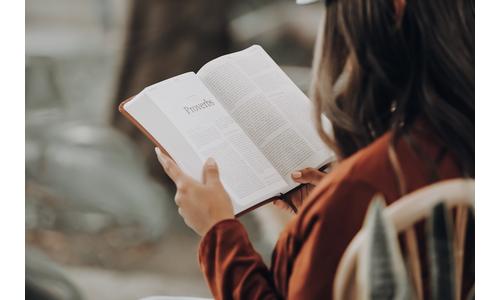Reading the Bible as a Woman
By Denise Cooper-Clarke
This was the title I was given, but it is one I am uneasy with, for two reasons. First, it implies that women are a separate category of reader from the normative reader, who is, of course a man. It is not helpful to think of a woman’s perspective as if this were distinct from an “objective†perspective (understood as a male perspective). This is to assume the priority of the male. Was any man ever invited to write an article on “Reading the Bible as a Man� Probably not, as until the last fifty years or so, reading, interpreting and teaching the Bible were the province of men. And white men, at that. For many years it was assumed that the standard (impartial or neutral) reading is a white male one, and that reading by women or people of colour, the poor or the disabled or any other group, are deviations or specialised readings. Yet every person reads from their own particular perspective, and no one perspective should be privileged above the others.
Second, this title implies that there is a specifically female way of reading the Scriptures that is common to all women. But though women do share some experiences, we cannot speak of a single “woman’s perspective†or “woman’s readingâ€. A woman’s perspective (like a man’s) is shaped by her particular historical, cultural, social, family and educational back ground and her particular experience. So I cannot speak to how all women read the Bible: only to how I read it as a white, Australian, wealthy, educated, Anglican, baby boomer, wife, mother and grandmother, with a whole range of other particularities (not to say, peculiarities).
Nevertheless, I can identify a number of ways in which my being a woman has shaped my reading of the biblical text. I will discuss them under four headings: gender accurate translations, the dominance of men in the biblical texts, the treatment of women in the Old testament and the treatment of women in the New Testament.
Gender accurate translations
I say gender accurate rather than gender inclusive, because ‘gender inclusive’ could be misunderstood to mean that the biblical text is being meddled with to make it inclusive or politically correct where it originally isn’t. But actually, it is English translations that up until recently (and some still do) have obscured the gender inclusiveness of many biblical texts. When I was a teenager, the dominance of masculine language in all English texts was standard and did not bother me. I accepted that “man†included “woman†and that “he†included “sheâ€, despite the ambiguity and potential confusion of each of these words being used both to include and to exclude women (sometimes “man†or “he†meant a man or a woman, and sometimes it meant a man and not a woman). The generic usage of “man†and “he†reflects the hidden norm that the prototypical human is male. And it is unnecessary, because English, like both Hebrew and Greek, has perfectly good words that include both male and female. In English, “human†(being) and “personâ€.
Gradually, English usage changed and people were more careful to specify whether they meant man or human. But Biblical translations (and commentaries) lagged behind. So what was I as a young Christian in my twenties, fresh from reading Germaine Greer, to make of “The true light that enlightens every man was coming into the world (John 1:9, RSV) or “Him we proclaim, warning every man and teaching every man in all wisdom, that we may present every man mature in Christ.” (Col 1:28, RSV), or any number of other examples where the Greek anthropos, which in these contexts clearly includes both man and woman, was translated “manâ€? Or what about “Then Jesus told his disciples, “If any man would come after me, let him deny himself and take up his cross and follow me”(RSV), where there is no word for either man or human in the original text, which reads “if any would come after me…â€. Was I included or not? And if I were included, was it just as an afterthought, as a second-class Christian?
Thankfully, most modern translations are gender accurate and women know they are included: “Then Jesus said to his disciples, ‘Whoever wants to be my disciple must deny themselves and take up their cross and follow me.’†(Matt 16: 24, NIV).
The dominance of men in the biblical texts
Even in a gender accurate translation, Scripture can be difficult for me to read as a woman. I’m not thinking of the New Testament passages that have been traditionally interpreted to mean that only men should lead or teach or preach in mixed congregations in the church (and sometimes that they should not have leadership roles outside the church, either) and that women should be unilaterally subordinate to their husbands. I am convinced by the scholarly arguments that these texts are misinterpreted when they are used to subordinate women to men in the home, the church and the world. Nor do I want to downplay the tremendous encouragement there is for women in much of the Bible, especially in the example of Jesus.
But… there is the obvious fact that, as far as we know, all the books of the Bible were written by men. (It has been plausibly argued that the unknown author of the letter to the Hebrews is Priscilla, but the evidence is inconclusive.) Inspiring and useful as the Psalms are for anyone, man or woman, I can’t help but think how good it would be to have even one of the canonical Psalms attributed to a woman and written from a woman’s experience. On the other hand, we do have several beautiful songs in Scripture written and sung by women at key moments in Israel’s history- the Songs of Miriam, Deborah, Hannah and Mary.
With the possible exception of Ruth and Esther, the main protagonists in the biblical narratives are men. Yes, there is Deborah in the Old Testament, though she is but one of eleven Judges, and Mary the mother of Jesus in the New Testament, but how many other women ‘heroes’ of the Bible spring to mind? Or women prophets? All the ‘big names’ are men, though the woman prophet Huldah exercised a significant ministry (2 Kings 22:14-20). Aimee Byrd speaks of the “gynocentric interruptions†to what is otherwise an androcentric text (Recovering from Biblical Manhood and Womanhood, Zondervan Academic, 2020).
The treatment of women in the Old Testament
I do not refer here to the many biblical stories of women being badly treated, though they are perhaps especially distressing for a woman to read. But there are also many biblical stories of men being badly treated: what I wish to draw attention to is the way that the women in these Old Testament narratives are treated (or seem to be treated) by the biblical narrator. Psalm 68: 11 tells us that “The Lord announces the word, and the women who proclaim it are a mighty throngâ€, but where are these women proclaiming the word of the Lord? In most of the Old Testament narratives, women are not only largely invisible, but when they do appear, they are often nameless and/or voiceless. Among these many nameless women are the witch of Endor, the wise woman of Tekoa and the Queen of Sheba. Some of them are designated simply as the wife or daughter of a named man: for example, Noah’s wife, or Lot’s wife and daughters, or Jephthah’s daughter. This might be understandable if they do not play a significant role on the story, but that cannot be said of Pharaoh’s daughter, or Potiphar’s wife. Why aren’t they named? Unusually, in the book of Job, Job’s daughters are named (Jemima, Keziah and Keren-Happuch), but not his wife or sons. (Job 42: 14).
Then there are stories where women are named and are significant in the narrative, but nevertheless are voiceless. In Genesis 34 we read the story of how Dinah, a daughter of Jacob, is abducted and raped, and of the violent and treacherous vengeance wrought by her brothers. The focus of the narrative throughout is on her attacker and his father, and on Dinah’s brothers. We do not know what Dinah thought or felt and she does not speak at all in the narrative. Similarly, in the whole sorry story of David, Bathsheba and Uriah, there is no record of Bathsheba saying anything apart from her message to David, “I am pregnantâ€(2 Samuel 11).
In perhaps one of the most brutal stories in the Bible, the nameless and voiceless “Levite’s concubine†is gang raped and dismembered (possibly still alive), and her body parts distributed to the twelve areas of Israel (Judges 19). But for Phyllis Trible, what makes this a “text of terror†is that the narrator fails to respond to her suffering in any way. Does the narrator condemn it or not? Since we understand the Bible as the word of God, to what extent does the narrator’s view reflect God’s view? Trible defines ‘texts of terror†as “texts which explicitly present stories of violence against women, where we must wrestle with the silence, absence or opposition of God†(Texts of Terror, Philadelphia, Fortress Press, 1). She also includes under this heading the stories of Hagar, sent out by Abraham and Sarah to die with her young son in the desert (Genesis 21); Tamar, daughter of King David, raped by her half- brother (2 Samuel 13); and the truly chilling tale of Jephthah’s daughter, who is literally sacrificed by her own father (Judges 11).
Such texts have led many feminist scholars to conclude that the Bible is “irredeemably patriarchal†and that “one cannot therefore, accept the bible’s authority and also embrace feminist perspectivesâ€, as noted by Andrew Sloane (ed) in Tamar’s Tears: Evangelical Engagements with Feminist Old Testament Hermeneutics (xi). However, Sloane’s book is based on the premise that it is indeed possible to be both feminist and evangelical, though the various authors express this in different ways. I found it tremendously helpful in looking again at some of these texts to attempt to read “with the text and against androcentric interpretations†(Tamar’s Tears, 35). A large part of the problem is not the text itself, but traditional male centred interpretations.
Despite these difficulties, I have no doubt that the gospel is good news for women. Indeed, the New Testament unequivocally affirms women. Which brings me to my final section.
The treatment of women in the New Testament
With the influence of an increasing number of women in biblical studies and theology, attention has been drawn to the place of women in the New Testament. And so I, along with many others, now notice what was often overlooked, ignored or dismissed by generations of male scholars and commentators.
I notice the five women (Tamar, Rahab, Ruth, Bathsheba and Mary) in the genealogy at the very beginning of Matthew’s Gospel. Unlike the other genealogies of the Old and New Testaments, and in defiance of tradition, this genealogy includes women, not just men. In this way Matthew intentionally foreshadows the radical way Jesus will include women in his ministry, and treat them as equals with men.
I notice the way that Luke’s Gospel pairs stories of men and women: an angel appears to Zechariah and then to Mary; both Simeon and Anna prophesy at Jesus’ birth; Jesus heals a possessed man and Peter’s mother in law at Capernaum; he heals both the Gerasene demoniac and the woman with the issue of blood of chronic debilitating illness; he heals both a crippled woman and a man with dropsy on the Sabbath; he tells the parables of the shepherd looking for a lost sheep and the woman looking for a lost coin; and his parables on prayer are about a persistent widow and a tax collector.
I notice that in John’s Gospel it is a woman (the unnamed woman of Samaria) to whom Jesus first reveals his identity as the Messiah (John 4:26), and that it is a woman, Martha, who declares that Jesus is the Messiah (John 11:27), which matches Peter’s declaration in the synoptics.
I notice that on the Day of Pentecost Peter quotes from the prophet Joel:
“In the last days, God says,
I will pour out my Spirit on all people.
Your sons and daughters will prophesy,
your young men will see visions,
your old men will dream dreams.
Even on my servants, both men and women,
I will pour out my Spirit in those days,
and they will prophesy.â€
I notice the female slave who had a spirit of divination, I notice Lydia the house church leader and Priscilla the teacher and Phoebe the deacon and Phillip’s four daughters who prophesied and Junia the apostle. I notice that among the co-workers Paul greets at the end of his letter to the church in Rome, there are ten women- nine of whom are mentioned by name.
I notice that Paul says, “There is neither Jew nor Gentile, neither slave nor free, nor is there male and female, for you are all one in Christ Jesus” (Galatians 3:28). Which brings us back full circle: I read the Bible as a believer, who happens to be a woman.
Denise Cooper-Clarke is a medical ethicist and researcher with Ethos.
This Paper was originally published in “Equip”, October 2020. Equip is published by Ethos EA Centre for Christianity & Society
Used by Permission





